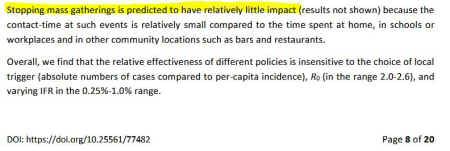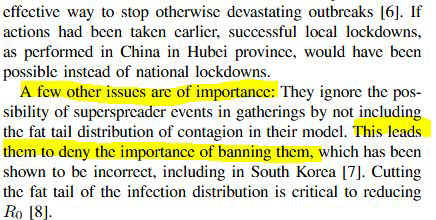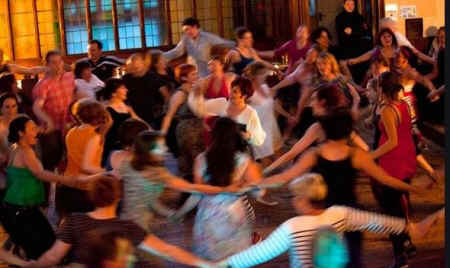Folk dancing and the importance of
other 'super-spreader' events - experience overseas
| Modelling work (the
theoretical basis of epidemiology) and implications for folk dance events. In the UK, modelling work is in part centred at
Imperial College under a group led by Professor Neil Ferguson. There is another group in
Oxford.
Neil
Ferguson's published paper of 16 March 2020 was swiftly condemned in one or two key
areas on 17 March by scientists from the USA: their criticism aligned with my own
intuitive reasoning of the possible importance of folk dance events in spreading the
virus, and centred upon what the authors called the 'fat tail distribution' in the model.
Their paper can be accessed here
- an extract is shown opposite.
My own concern centred on the close proximity of dozens or hundreds of dancers all
holding hands with each other and being in very close proximity often in crowded venues
and for several hours. Both the degree and proximity of contact would be much greater than
in a theatre or a placid church service, for example. In large outdoor marquees (like the
Ham at Sidmouth FolkWeek for example) 1200 people are crammed together for a couple of
hours in stifling conditions, and to get to their seats they hold onto numerous plastic
chair backs, on which viruses may live for a short while? (FolkWeek 2020 was cancelled in
late March, and subsequently for 2021 also).
Such gatherings could arguably lead to 'super-spreading' events where one infected person
(who may not be showing any symptoms of the disease) can infect tens or hundreds of people
- who then will return home from the event.
One possible 'super-spreader' event in
India was reported here.
A crowded folk dance event anywhere in the world has obvious parallels.
Images - a paragraph from Prof. Ferguson's report (16 March 2020), criticism of the
Ferguson paper having missed some key points, and a typical ceilidh in the UK. Folk
festival ceilidhs can be more (or sometimes less) crowded! Hundreds of people, many in a
vulnerable age range, can be mixed together, and for several hours. It is great fun and
more people should take up the hobby - but not during the pandemic!
Other criticism of Prof. Ferguson's paper, by Tomas Pueyo in the USA, is discussed below
also: The
hammer and the dance. |


 |
Super-spreading events and people.
The view from Italy:
I’m with you on this one Steve - I think Ferguson’s talkin' bullshit.
Off the top of head just as examples (Madrid Feminists aside) the biggest outbreaks so
far in Lazio
(Fondi)* & Catalunya
(Igualada) were both started when just 1 infected person mingled with others (in the
former the granddad of someone who came down from Lombardy to a carnival party for 80
elderly – which I’d bet serious money involved the gentle "ballo
liscio" dancing senior Italians much enjoy, in the latter a leaving dinner for a
co-worker attended by 80 hospital staff). Hardly mass gatherings, but deadly nonetheless.
It has been argued that the decision to hold the 8 March Feminists’ Strike rally
in Madrid (120,000 participants – skewed heavily towards the female-left-liberal
leaning & I’d confidently guess more likely to be overly representative of
healthcare workers in addition to madrilenos) may
have been a monumental mistake.
Notes added early 2021: time constants of infection?
I'm increasingly convinced infection arises either from short term high dose infection
(face to face for a minute or less or someone sneezing in your face) or prolonged
low-level exposure for an hour or more (a dance hall, restaurant or choir) . The
integrated dose is the same, and what matters may be that the integrated dose occurs over
a shorter time period than the response time of the immune system. So tiny doses spread
over days may not result in illness because at each micro infection the immune system
resets the body to zero before the next micro dose. Unfortunately, the accumulation of
small exposures experienced during a few hours in a dance hall may produce illness. So
having dance halls very well ventilated may be a key part of making them as safe as
possible.
0. Index page.
1. Wet markets, abuses of wildlife, organised crime and the origins
of the virus.
2. Folk dancing and the importance of other 'super-spreader' events -
experience overseas.
3. Scientists, government scientists, and criticisms of government
policy in the UK.
4. How many people will die - no-one can tell until the final
reckoning.
5. Policing of lockdown in the UK - the need for police reform
(starting at the top?).
6. Religious nutcases and despotic governments (often the same
people!)
7. Economics vs. Health - the lockdown cure being worse than the
disease?
8. Ventilators and cures.
9. Shaggy dog stories - and wash your hands.
10. Reserved.
Home page of website